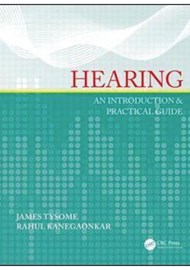Hearing: An Introduction & Practical Guide presents a concise overview of the anatomy, physiology, and assessment methods of hearing. It then goes on to delineate and explore the most common pathologies, disorders and management approaches related to hearing impairment.
This latter concern represents the largest section of the book, seeking to provide a “practical guide on how to assess and manage patients with all aspects of hearing loss”. It accomplishes this within the confines of a sub-200-page text. Compact, and with a clear layout, at times it packs surprisingly focused and pertinent detail into brief discussions of vast topics. A good example is the chapter on physiology, which touches on temporal coding of auditory nerve fibres as well as the phenomenon of ‘hidden hearing loss’ related to selective neural degeneration.
The chapter authors are clearly experienced practitioners, and this is reflected in the practically-oriented discussions. A short section on Eustachian-tube dysfunction concludes honestly that the “evidence guiding assessment and treatment […] is poor” – no obfuscation here, which is refreshing. In general, approaches to management are related to recent evidence, and the evidence is appraised. Although the book was published in 2016, the broadness of its scope ensures these inferences are still largely valid.
Aimed at ENT surgeons, general practitioners and trainees, the book likely has differing utility according to its reader. For the GP it may be detailed enough to be complete in itself, whereas for the otologist it might serve as an aid to giving brief explanations to patients or trainees. It is certainly useful and informative, and could gain a wider audience amongst audiologists with a desire to better understand the medical/surgical work their tests underpin. As with all specialist texts, it is not cheap, but it is on the more modest side and worth the investment.




